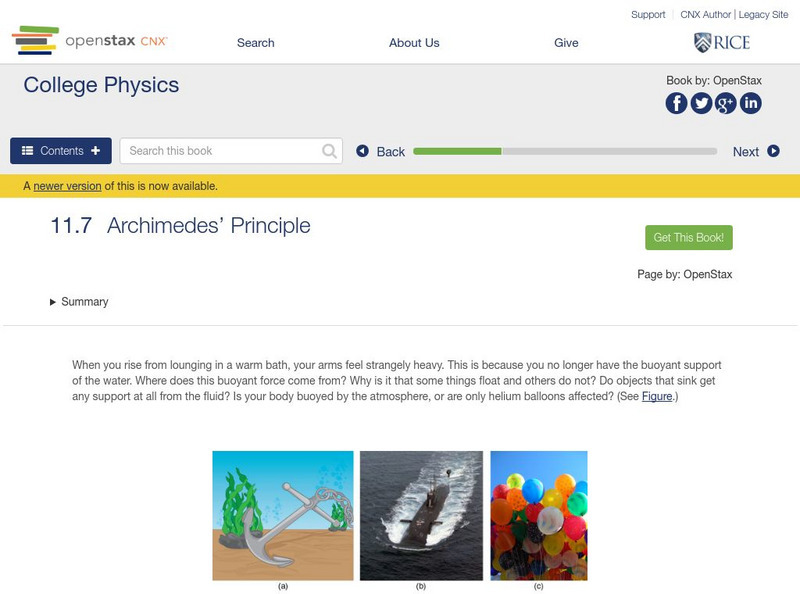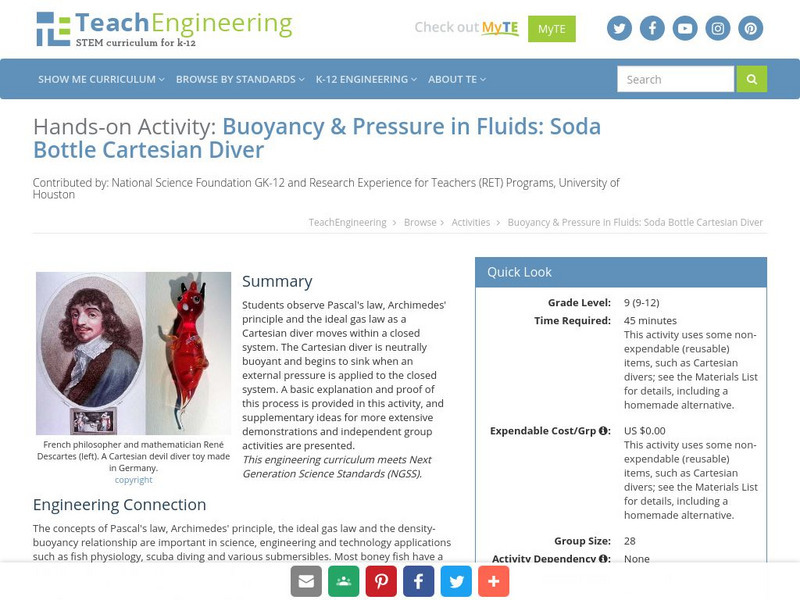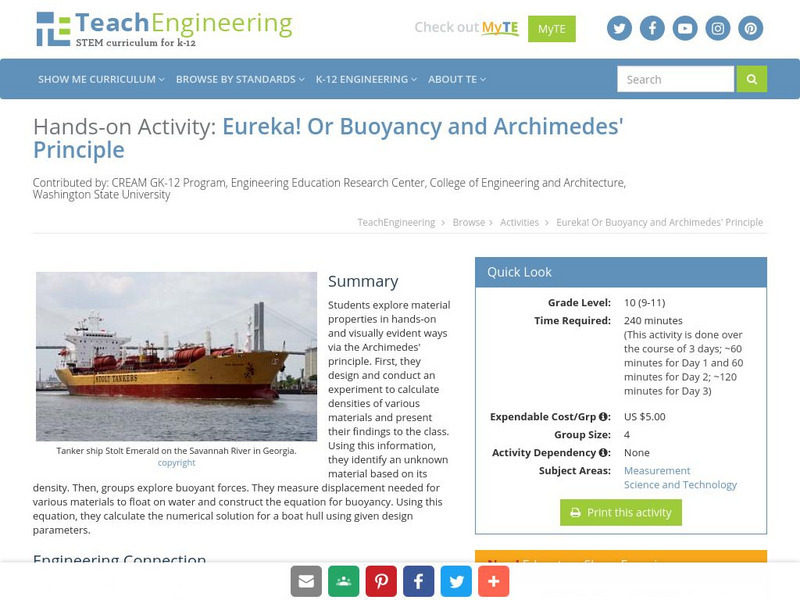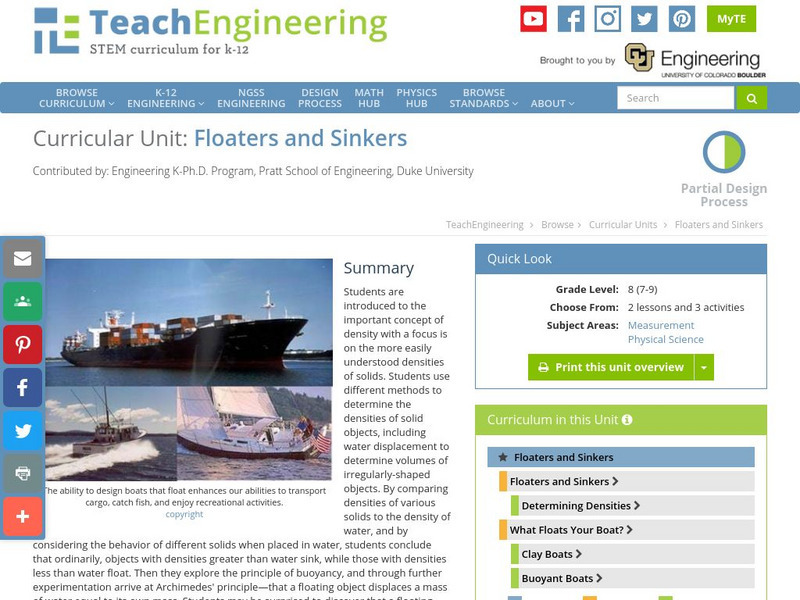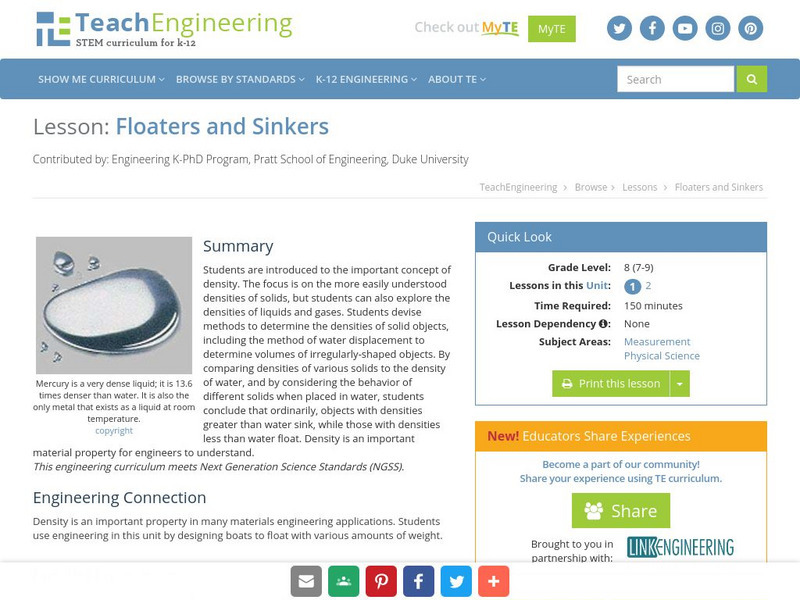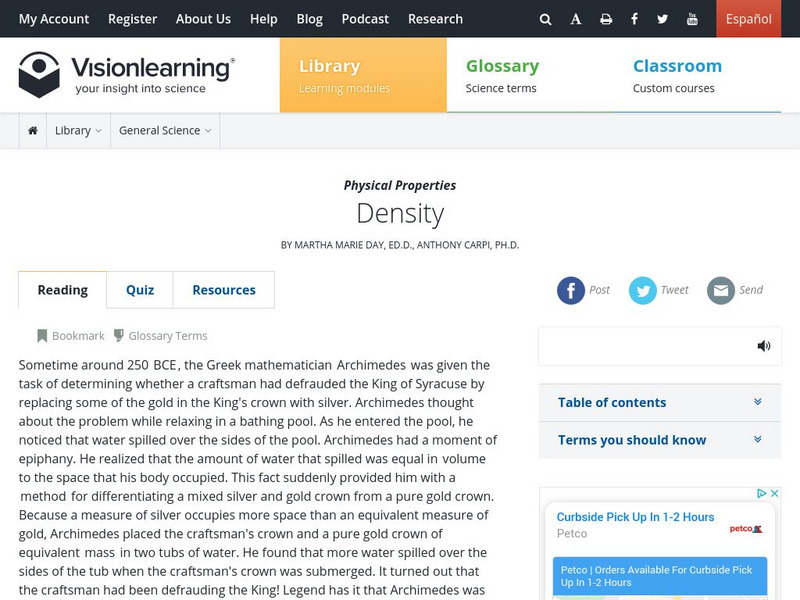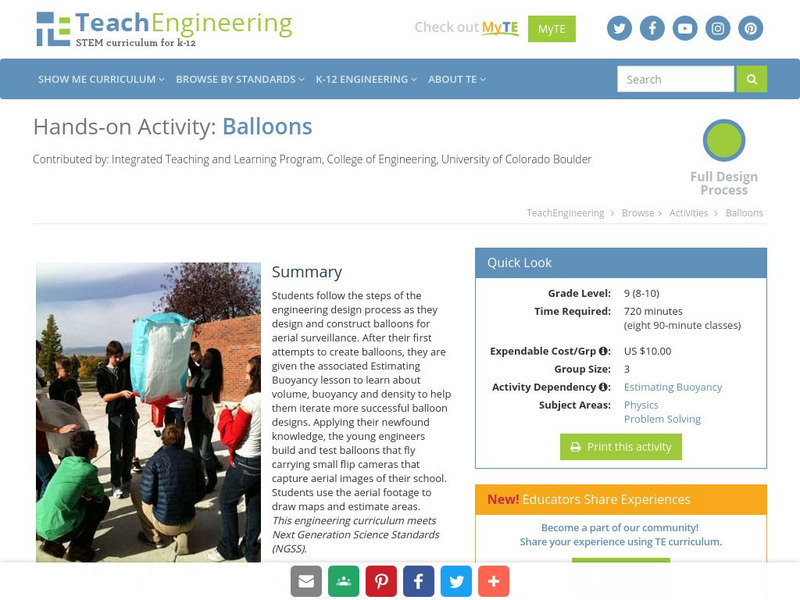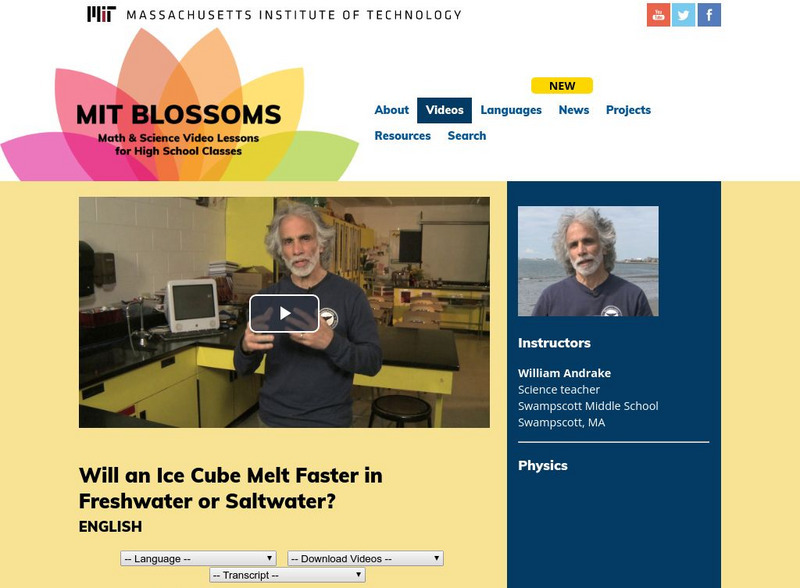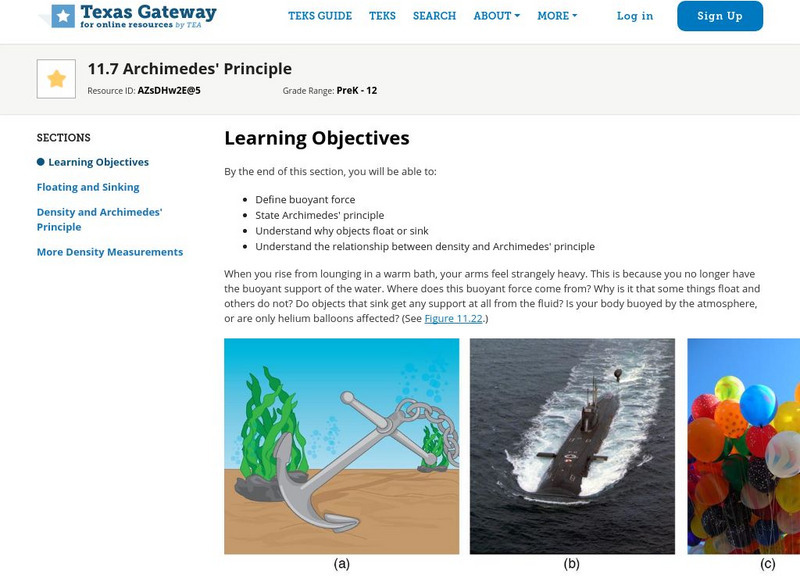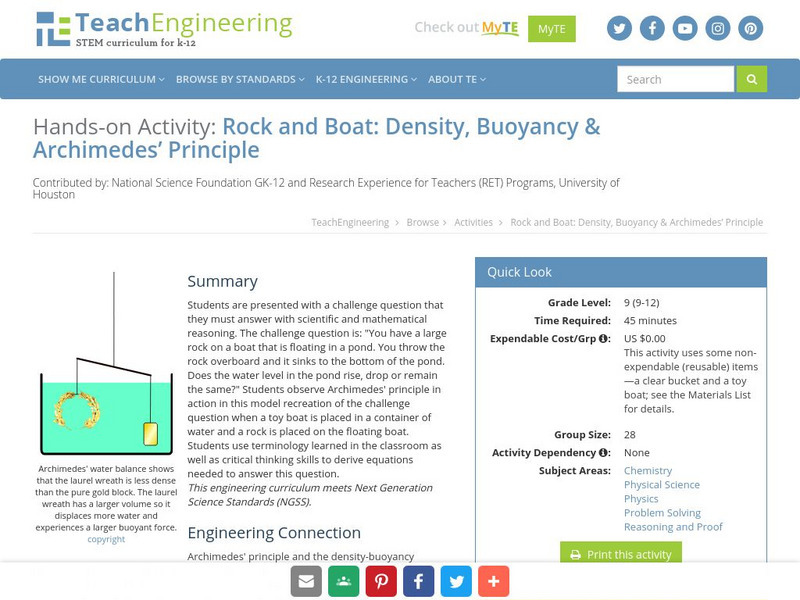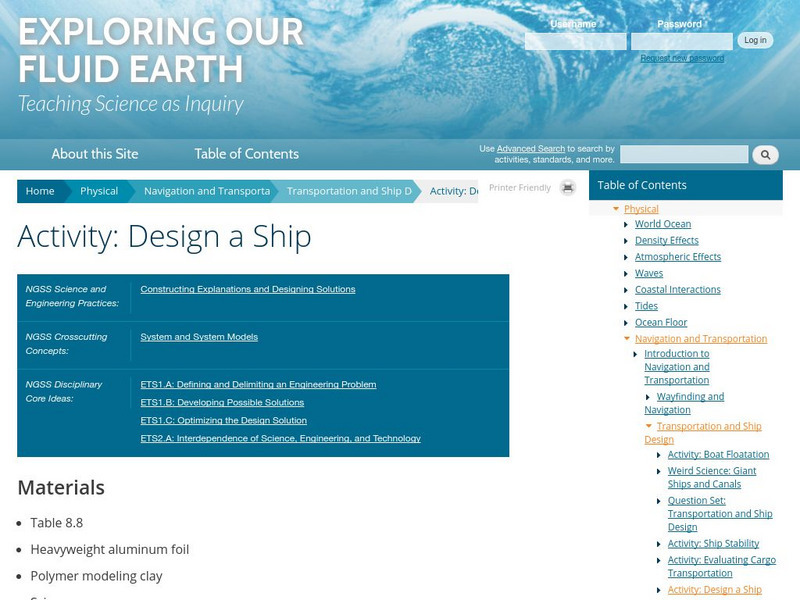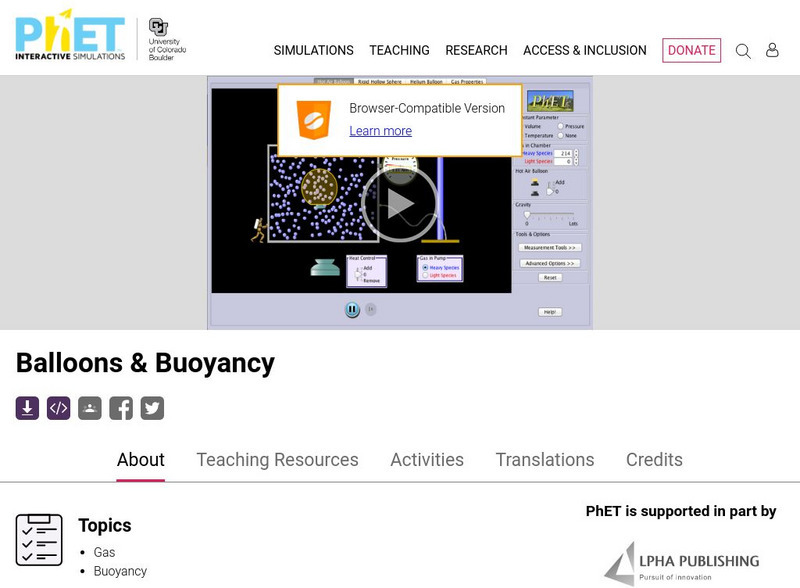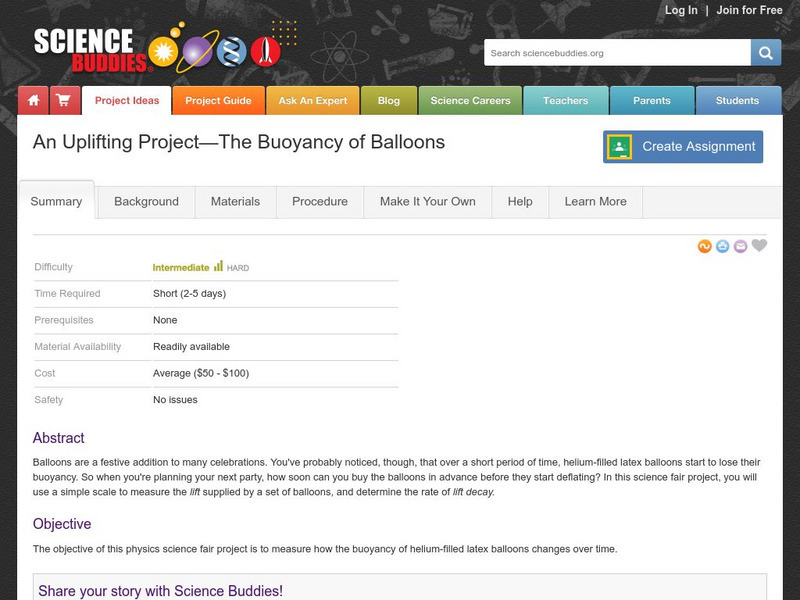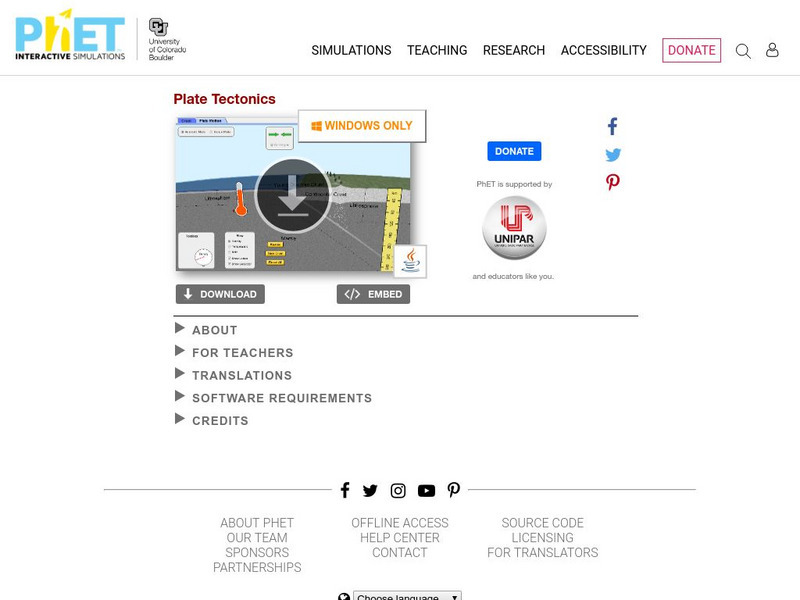Google
The Engineering Place: Balloon Flinking [Pdf]
A activity and activity sheet on buoyancy. Students add weight to a helium-filled balloon to keep it suspended so that it won't float or sink, but instead will 'flink.'
OpenStax
Open Stax: Physics: Archimedes' Principle
From a chapter on Fluid Statics in a Physics textbook. This section of the chapter provides a detailed discussion of Archimedes' principle, buoyant force, floating and sinking, and the role of density. Includes questions, problems and...
TeachEngineering
Teach Engineering: Cartesian Diver
Students observe Pascal's law, Archimedes' principle, and the ideal gas law as a Cartesian diver moves within a closed system.
TeachEngineering
Teach Engineering: Eureka! Or Buoyancy and Archimedes' Principle
Students explore material properties in hands-on and visually evident ways via the Archimedes' principle. First, they design and conduct an experiment to calculate densities of various materials and present their findings to the class....
TeachEngineering
Teach Engineering: Floaters and Sinkers
Through this curricular unit, students are introduced to the important concept of density. The focus is on the more easily understood densities of solids, but students may also explore the densities of liquids and gases. Students devise...
TeachEngineering
Teach Engineering: The Physics of Fluid Mechanics
Five lessons about the study of fluid mechanics. The unit concludes with students applying what they have learned to determine the stability of individual above-ground storage tanks given specific storm conditions so they can analyze...
TeachEngineering
Teach Engineering: Estimating Buoyancy
Young scholars learn that buoyancy is responsible for making boats, hot air balloons and weather balloons float. They calculate whether or not a boat or balloon will float, and calculate the volume needed to make a balloon or boat of a...
TeachEngineering
Teach Engineering: Floaters and Sinkers
This lesson introduces students to the important concept of density. The focus is on the more easily understood densities of solids, but students can also explore the densities of liquids and gases. Students devise methods to determine...
TeachEngineering
Teach Engineering: What Floats Your Boat?
Learners use modeling clay, a material that is denser than water and thus ordinarily sinks in water, to discover the principle of buoyancy. They begin by designing and building boats out of clay that will float in water, and then refine...
Vision Learning
Visionlearning: General Science: Density
Instructional module focusing on density as a physical property of matter. Discussion incorporates historical references as well as formulas. Site also includes an interactive practice quiz and links relating to the topic.
TeachEngineering
Teach Engineering: Balloons
Students follow the steps of the engineering design process as they design and construct balloons for aerial surveillance. After their first attempts to create balloons, they are given the associated Estimating Buoyancy lesson to learn...
University of Colorado
University of Colorado: Ph Et Interactive Simulations: Plate Tectonics
Explore how plates move on the surface of the earth. Change temperature, composition, and thickness of plates. Discover how to create new mountains, volcanoes, or oceans! Java is required.
Massachusetts Institute of Technology
Mit: Blossoms: Will an Ice Cube Melt Faster in Freshwater or Saltwater?
Engage students in the study of the ocean and saltwater with these activities. Students will see that saltwater has different physical properties than freshwater - mainly density. This lesson can serve as a springboard into other...
Texas Education Agency
Texas Gateway: Ap Physics: Fluid Statics: Archimedes' Principle
By the end of this section, you will be able to define buoyant force, state Archimedes' principle, understand why objects float or sink, and understand the relationship between density and Archimedes' principle.
Utah Education Network
Uen: Sink or Float
Predict and test everyday objects as to whether they sink or float.
Utah Education Network
Uen: Nhmu: Boy, Is That Buoyant!
Learn how salt increases the density of water and creates a condition of buoyancy.
TeachEngineering
Teach Engineering: Rock and Boat
Students observe Archimedes' principle in action in this challenge where a toy boat is placed in a container of water and a rock is placed on the floating boat. Students must explain why the water level rises/falls/stays the same based...
University of Hawai'i
University of Hawai'i: Exploring Our Fluid Earth: Activity: Design a Ship
In this activity, students apply their knowledge of buoyancy and ship stability to design a model ship. They test, evaluate, and refine the design of the model to optimize performance. Background information and other activities are...
Massachusetts Institute of Technology
Mit: Open Course Ware: Buoyancy
Students explore buoyancy. Some topics examined in the activities are buoyant force, stability of floating objects, and Archimedes' principle. The resource consists of video clips, lecture notes, practice problems, and exam questions....
Center of Science and Industry
Cosi Columbus: Buoyant Bubble [Pdf]
Learn about density in this hands-on science experiment. Includes full list of materials, procedures, and scientific explanation of what makes an object float or sink. [PDF]
University of Colorado
University of Colorado: Ph Et Interactive Simulations: Balloons & Buoyancy
Students studying buoyancy will better understand its concepts with this virtual experiment using various balloons and testing what makes them float or sink.
Science Buddies
Science Buddies: An Uplifting Project: The Buoyancy of Balloons
In this science fair project, measure the "lift" of a set of balloons and track how it changes over time as the helium escapes from the balloons. The Science Buddies project ideas are set up consistently beginning with an abstract,...
University of Colorado
University of Colorado: Ph Et Interactive Simulations: Ph Et: Interactive Simulations: Plate Tectonics
Students studying plate tectonics will better understand its concepts with this virtual experiment that tests how plates move on the surface of the earth. Temperature, composition, and thickness of plates can be changed to create new...
Science Education Resource Center at Carleton College
Serc: Investigating Density: Determined by Using Mass and Volume of a Substance
In this activity, learners investigate the history of density, its uses, and applications. Students will generate and calculate data applying it to a graph. They will be looking at the relationship between mass and volume.


![The Engineering Place: Balloon Flinking [Pdf] Lesson Plan The Engineering Place: Balloon Flinking [Pdf] Lesson Plan](https://content.lessonplanet.com/knovation/original/172615-2de503a48a3b9f1faaa61527a0b2e7e4.jpg?1661554798)
